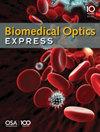Alternating projection combined with fast gradient projection (FGP-AP) method for intensity-only measurement optical diffraction tomography in LED array microscopy
IF 2.9
2区 医学
Q2 BIOCHEMICAL RESEARCH METHODS
引用次数: 0
Abstract
Optical diffraction tomography (ODT) is a powerful label-free measurement tool that can quantitatively image the three-dimensional (3D) refractive index (RI) distribution of samples. However, the inherent "missing cone problem," limited illumination angles, and dependence on intensity-only measurements in a simplified imaging setup can all lead to insufficient information mapping in the Fourier domain, affecting 3D reconstruction results. In this paper, we propose the alternating projection combined with the fast gradient projection (FGP-AP) method to compensate for the above problem, which effectively reconstructs the 3D RI distribution of samples using intensity-only images captured from LED array microscopy. The FGP-AP method employs the alternating projection (AP) algorithm for gradient descent and the fast gradient projection (FGP) algorithm for regularization constraints. This approach is equivalent to incorporating prior knowledge of sample non-negativity and smoothness into the 3D reconstruction process. Simulations demonstrate that the FGP-AP method improves reconstruction quality compared to the original AP method, particularly in the presence of noise. Experimental results, obtained from mouse kidney cells and label-free blood cells, further affirm the superior 3D imaging efficacy of the FGP-AP method.交替投影结合快速梯度投影 (FGP-AP) 法用于 LED 阵列显微镜中的纯强度测量光学衍射层析成像技术
光学衍射层析成像(ODT)是一种强大的无标记测量工具,可对样品的三维折射率(RI)分布进行定量成像。然而,在简化的成像装置中,固有的 "缺失锥问题"、有限的照明角度以及对纯强度测量的依赖都会导致傅里叶域的信息映射不足,从而影响三维重建结果。在本文中,我们提出了交替投影结合快速梯度投影(FGP-AP)方法来弥补上述问题,该方法能利用 LED 阵列显微镜捕获的纯强度图像有效地重建样品的三维 RI 分布。FGP-AP 方法采用交替投影(AP)算法进行梯度下降,并采用快速梯度投影(FGP)算法进行正则化约束。这种方法相当于将样本非负性和平滑性的先验知识纳入三维重建过程。模拟结果表明,与原始 AP 方法相比,FGP-AP 方法提高了重建质量,尤其是在存在噪声的情况下。小鼠肾脏细胞和无标记血细胞的实验结果进一步证实了 FGP-AP 方法卓越的三维成像效果。
本文章由计算机程序翻译,如有差异,请以英文原文为准。
求助全文
约1分钟内获得全文
求助全文
来源期刊

Biomedical optics express
BIOCHEMICAL RESEARCH METHODS-OPTICS
CiteScore
6.80
自引率
11.80%
发文量
633
审稿时长
1 months
期刊介绍:
The journal''s scope encompasses fundamental research, technology development, biomedical studies and clinical applications. BOEx focuses on the leading edge topics in the field, including:
Tissue optics and spectroscopy
Novel microscopies
Optical coherence tomography
Diffuse and fluorescence tomography
Photoacoustic and multimodal imaging
Molecular imaging and therapies
Nanophotonic biosensing
Optical biophysics/photobiology
Microfluidic optical devices
Vision research.
文献相关原料
| 公司名称 | 产品信息 | 采购帮参考价格 |
|---|
 求助内容:
求助内容: 应助结果提醒方式:
应助结果提醒方式:


